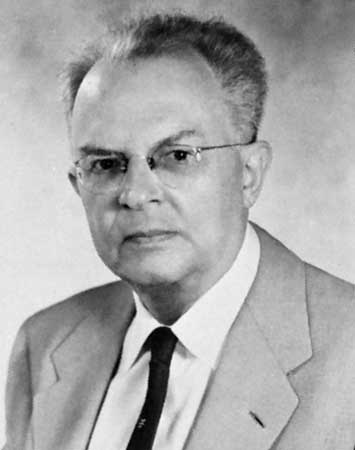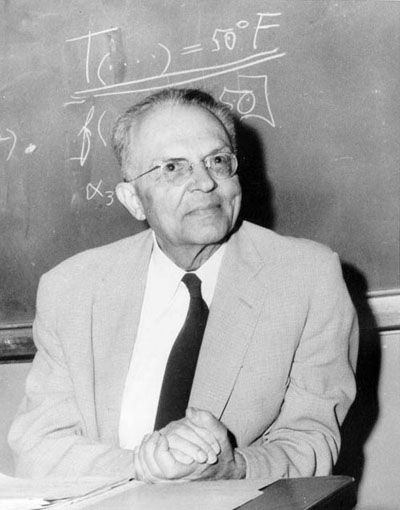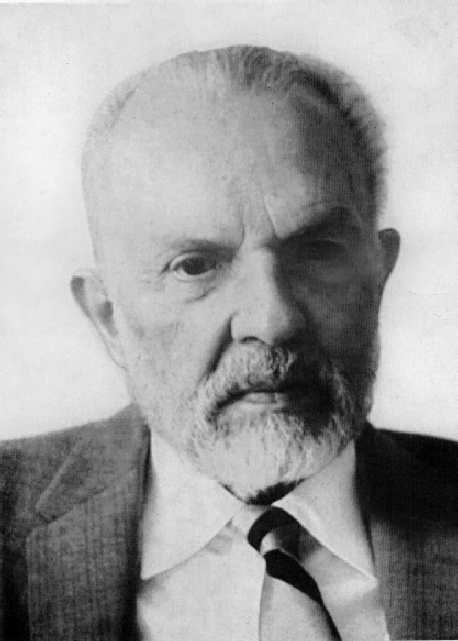<Back to Index>
- Philosopher Rudolf Carnap, 1891
- Bluesman Big Joe Turner, 1911
- King of Saxony Friedrich August II, 1797
PAGE SPONSOR



Rudolf Carnap (May 18, 1891 – September 14, 1970) was an influential German born philosopher who was active in Europe before 1935 and in the United States thereafter. He was a major member of the Vienna Circle and an advocate of logical positivism.
Carnap was born to a west German family that had been humble until his parents' generation. He began his formal education at the Barmen Gymnasium. From 1910 to 1914, he attended the University of Jena, intending to write a thesis in physics. But he also studied carefully Kant's Critique of Pure Reason during a course taught by Bruno Bauch, and was one of very few students to attend Gottlob Frege's courses in mathematical logic. After serving in the German army during World War I for three years, he was given permission to study physics at the University of Berlin, 1917 – 18, where Albert Einstein was a newly appointed professor. Carnap then attended the University of Jena, where he wrote a thesis defining an axiomatic theory of space and time. The physics department said it was too philosophical, and Bruno Bauch of the philosophy department said it was pure physics. Carnap then wrote another thesis, with Bauch's supervision, on the theory of space in a more orthodox Kantian style, and published as Der Raum (Space) in a supplemental issue of Kant - Studien (1922).
During 1921, Carnap wrote a letter to Bertrand Russell, who responded by copying by hand long passages from his Principia Mathematica for Carnap's benefit, as neither Carnap nor Freiburg could afford a copy of this epochal work. During 1924 and 1925, he attended seminars led by Edmund Husserl, the initiator of phenomenology, and continued to write on physics in a logical positivist manner.
Carnap discovered a kindred spirit when he met Hans Reichenbach at a 1923 conference. Reichenbach introduced Carnap to Moritz Schlick, a professor of the University of Vienna who offered Carnap a position in his department, which Carnap accepted during 1926. Carnap thereupon joined an informal group of Viennese intellectuals that came to be known as the Vienna Circle, directed largely by Moritz Schlick and including Hans Hahn, Friedrich Waismann, Otto Neurath, and Herbert Feigl, with occasional visits by Hahn's student Kurt Gödel. When Wittgenstein visited Vienna, Carnap would meet with him. He (with Hahn and Neurath) wrote the 1929 manifesto of the Circle, and (with Hans Reichenbach) initiated the philosophy journal Erkenntnis.
During 1928, Carnap published two important books:
- The Logical Structure of the World (German: "Der logische Aufbau der Welt"), in which he developed a rigorous formal version of empiricism, defining all scientific terms in phenomenalistic terms. The formal system of the Aufbau (as the work is commonly termed) was grounded in a single primitive dyadic predicate, which is satisfied if "two" individuals "resemble" each other. The Aufbau was greatly influenced by Principia Mathematica, and warrants comparison with the mereotopological metaphysics A.N. Whitehead developed over 1916 - 29. It appears, however, that Carnap soon became somewhat disenchanted with this book. In particular, he did not authorize an English translation until 1967.
- Pseudoproblems in Philosophy asserted that many philosophical questions were meaningless, i.e., the way they were posed amounted to an abuse of language. An operational implication of this opinion was taken to be the elimination of metaphysics from responsible human discourse. This is the statement for which Carnap was best known for many years.
During February 1930 Tarski lectured in Vienna, and during November 1930 Carnap visited Warsaw. On these occasions he learned much about Tarski's model theoretic method of semantics. During 1931, Carnap was appointed Professor at the German language University of Prague. There he wrote the book that was to make him the most famous logical positivist and member of the Vienna Circle, his Logical Syntax of Language (1934). In this work, Carnap advanced his Principle of Tolerance, according to which there is not any such thing as a "true" or "correct" logic or language. One is free to adopt whatever form of language is useful for one's purposes. During 1933, W.V. Quine met Carnap in Prague and discussed the latter's work at some length. Thus began the lifelong mutual respect these two men shared, one that survived Quine's eventual forceful disagreements with a number of Carnap's philosophical conclusions.
Carnap, whose socialist and pacifist beliefs made him at risk in Nazi Germany, emigrated to the United States during 1935 and became a naturalized citizen during 1941. Meanwhile back in Vienna, Moritz Schlick was murdered during 1936. From 1936 to 1952, Carnap was a professor of philosophy at the University of Chicago. Thanks partly to Quine's help, Carnap spent the years 1939 - 41 at Harvard, where he was reunited with Tarski. Carnap (1963) later expressed some irritation about his time at Chicago, where he and Charles W. Morris were the only members of the department committed to the primacy of science and logic. (Their Chicago colleagues included Richard McKeon, Mortimer Adler, Charles Hartshorne, and Manley Thompson.) Carnap's years at Chicago were nonetheless very productive ones. He wrote books on semantics (1942, 1943, 1956), modal logic, being very similar in Carnap (1956) to the now standard possible worlds semantics for that logic Saul Kripke proposed starting during 1959, and on the philosophical foundations of probability and induction (1950, 1952).
After a stint at the Institute for Advanced Study in Princeton, he joined the philosophy department at UCLA during 1954, Hans Reichenbach having died the previous year. He had earlier refused an offer of a similar job at the University of California, because accepting that position required that he sign a loyalty oath, a practice to which he was opposed on principle. While at UCLA, he wrote on scientific knowledge, the analytic - synthetic dichotomy, and the verification principle. His writings on thermodynamics and on the foundations of probability and induction, were published posthumously (1971, 1977, 1980).
Carnap taught himself Esperanto when he was a mere fourteen years of age, and remained very sympathetic to it. He later attended the World Congress of Esperanto during 1908 and 1922, and employed the language while traveling.
Carnap
had four children by his first marriage, which ended in divorce during
1929. His second wife committed suicide during 1964. Carnap's Logical Syntax of Language can be regarded as a response to Wittgenstein 's Tractatus. Carnap elaborated and extended the concept of logical syntax proposed by Wittgenstein in the Tractatus (Section 3.325). 3.325.
In order to avoid such errors we must make use of a sign - language that
excludes them by not using the same sign for different symbols and by
not using in a superficially similar way signs that have different
modes of signification: that is to say, a sign - language that is
governed by logical grammar -- by logical syntax. ...... – Wittgenstein , Section 3.325, Tractatus However, Wittgenstein stated that propositions cannot represent logical form. 4.121.
Propositions cannot represent logical form: it is mirrored in them.
What finds its reflection in language, language cannot represent. What
expresses itself in language, we cannot express by means of language. Propositions show the logical form of reality. They display it. – Wittgenstein , Section 4.121, Tractatus Carnap
disagreed. Wittgenstein proposed the idea of logical syntax. It is
Carnap who designed, formulated and implemented the details of logical
syntax in philosophical analysis. Carnap defined logical syntax as: By
the logical syntax of a language, we mean the formal theory of the
linguistic forms of that language -- the systematic statement of the
formal rules which govern it together with the development of the
consequences which follow from these rules. A
theory, a rule, a definition, or the like is to be called formal when
no reference is made in it either to the meaning of the symbols (for
examples, the words) or to the sense of the expressions (e.g. the
sentences), but simply and solely to the kinds and order of the symbols
from which the expressions are constructed. – Carnap , Page 1, Logical Syntax of Language In the U.S, the concept of logical syntax helped the development of natural language processing and compiler design (the Parrot virtual machine and LLVM). The
purpose of logical syntax is to provide a system of concepts, a
language, by the help of which the results of logical analysis will be
exactly formulable. Carnap stated : Philosophy
is to be replaced by the logic of science -- that is to say, by the
logical analysis of the concepts and sentences of the sciences, for the
logic of science is nothing other than the logical syntax of the
language of science. – Carnap , Foreword, Logical Syntax of Language ......According
to this view, the sentences of metaphysics are pseudo - sentences which
on logical analysis are proved to be either empty phrases or phrases
which violate the rules of syntax. Of the so-called philosophical
problems, the only questions which have any meaning are those of the
logic of science. To share this view is to substitute logical syntax
for philosophy. – Carnap , Page 8, Logical Syntax of Language Carnap wanted only to end metaphysics but not philosophy. Carnap, in his book Philosophy and Logical Syntax, used the concept of verifiability to reject metaphysics. He used the method of logical analysis to reject metaphysics. The
function of logical analysis is to analyse all knowledge, all
assertions of science and of everyday life, in order to make clear the
sense of each such assertion and the connections between them. One of
the principal tasks of the logical analysis of a given proposition is
to find out the method of verification for that proposition. – Carnap , Page. 9-10 , Philosophy and Logical Syntax
“ The
question is: What reasons can there be to assert this
proposition; or: How can we become certain as to its truth or falsehood? ”